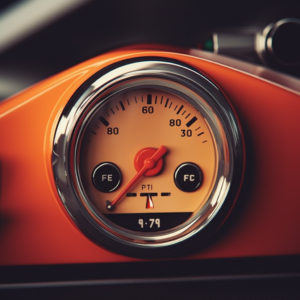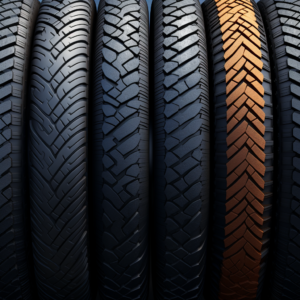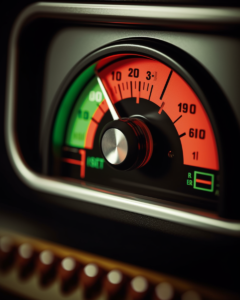Maximize fuel efficiency with new tires: Intro
In today’s world, where gas prices seem to be constantly on the rise, maximizing fuel efficiency has become a top priority for many drivers. While there are several ways to improve fuel economy, one often overlooked factor is the tires we use on our vehicles. As tires wear down over time, they can significantly decrease gas mileage, leading to more frequent trips to the pump and higher costs. But fear not, there are steps you can take to combat this issue. From selecting the right type of tire to maintaining proper inflation levels, we will cover everything you need to know to get the most out of your vehicle’s fuel economy. So, whether you are a daily commuter or a road trip enthusiast, read on to learn how to maximize fuel efficiency and get tips to combat decreased gas mileage with new tires.
Understanding the relationship between tires and gas mileage-
Tires can have a significant impact on gas mileage due to their rolling resistance, which is the force required to keep a tire rolling. When a tire rolls on the road surface, it creates friction, and this friction is known as rolling resistance. The higher the rolling resistance, the more energy is required to keep the tire rolling, and this can result in reduced gas mileage.
New tires can cause gas mileage to drop because they have higher rolling resistance than worn tires. This is because new tires have a thicker and stiffer tread, which increases their contact area with the road surface and creates more rolling resistance. Over time, as the tire wears down, the tread becomes thinner and more flexible, which reduces rolling resistance and can lead to better gas mileage.
Additionally, factors such as tire pressure and tire type can also affect gas mileage. Underinflated tires can increase rolling resistance, while overinflated tires can cause uneven wear and decrease tire lifespan. Choosing tires with lower rolling resistance, such as fuel-efficient or eco-friendly tires, can help to improve gas mileage.
Overall, while new tires may initially lead to a decrease in gas mileage due to higher rolling resistance, selecting the right tires, maintaining proper tire inflation, and being mindful of tire condition can all help to minimize the impact on fuel economy.

Maximize fuel efficiency with new tires- Signs
Decreased gas mileage:
New tires can be the cause of decreased gas mileage. Low tire pressure, worn or unevenly worn tires, or tires with high rolling resistance can all contribute to decreased gas mileage.
Uneven tire wear:
Uneven tire wear can indicate that your tires are not properly aligned or balanced. This can increase rolling resistance and cause decreased fuel efficiency.
Excessive road noise:
If your tires are making more noise than usual while driving, it could be a sign that they are not rolling smoothly. This can cause increased friction and decrease fuel efficiency.
Vibration while driving:
If you feel a vibration in the steering wheel or vehicle while driving, it could be a sign of an alignment or balancing issue with the tires. This can cause increased rolling resistance and reduce fuel efficiency.
Bulges, cracks or punctures:
Any damage to your tires such as bulges, cracks or punctures can cause air leakage and result in underinflated tires, which can increase rolling resistance and decrease fuel efficiency.
If any of the following indicators are present, it is crucial to seek professional tire inspection. Proper tire maintenance such as maintaining proper inflation, regular rotation, and alignment checks can help to ensure that your tires are functioning efficiently and not negatively impacting your fuel economy.

Maximize fuel efficiency with new tires-
Choosing the right tires for optimal fuel efficiency is an important consideration for drivers who want to minimize their fuel costs and reduce their environmental impact. Here are some tips for selecting fuel-efficient tires:
Look for reduced rolling resistance:
Tires with lower rolling resistance can help to reduce fuel consumption by requiring less energy to keep the tire rolling. Look for tires that are specifically designed for fuel efficiency, such as those labeled with the EPA’s Fuel-Efficient Tire Program.
Choose the right tire size:
Choosing the right tire size for your vehicle is important for maintaining optimal fuel efficiency. Using larger, wider tires can increase rolling resistance and decrease fuel efficiency. Stick with the tire size recommended by the vehicle manufacturer.
Consider tire type:
Different tire types can have varying levels of rolling resistance. For example, all-season tires generally have lower rolling resistance than winter tires. Choosing the right tire type for your driving needs can help to improve fuel efficiency.
Check the tread pattern:
Tires with a more aggressive tread pattern can have higher rolling resistance than those with a smoother tread pattern. Consider the type of driving you do and choose a tire with a tread pattern that best meets your needs.
Maintain proper tire pressure:
Proper tire inflation is crucial for maximizing fuel efficiency. Insufficient tire inflation can lead to heightened rolling resistance, resulting in a decline in overall fuel efficiency. Check your tire pressure regularly and keep them properly inflated to the recommended pressure levels.
By considering these factors and choosing fuel-efficient tires, you can help to reduce your fuel costs and minimize your environmental impact. It’s also important to maintain proper tire maintenance, including regular rotation and alignment checks, to ensure that your tires are functioning optimally.
Maximize fuel efficiency with new tires: Tips
Here are some tips for how you can maximize fuel efficiency with new tires:
Maintaining your tires is crucial for improving gas mileage and ensuring that your vehicle is operating safely and efficiently.
Check tire pressure regularly:
Proper tire inflation is crucial for maximizing fuel efficiency. Underinflated tires can increase rolling resistance, which can cause decreased fuel efficiency. Give your tires some love at least once a month, especially before embarking on epic road adventures!
Rotate your tires:
Regular tire rotation can help to ensure even wear and extend the lifespan of your tires. This can also improve fuel efficiency by reducing rolling resistance and ensuring that your tires are functioning optimally.
Keep your tires balanced:
Proper tire balancing can help to reduce vibration and improve handling, which can contribute to better gas mileage. Have your tires balanced regularly, especially if you notice any vibrations while driving.
Choose the right tires:
Choosing fuel-efficient tires with low rolling resistance can help to improve gas mileage. Look for tires labeled with the EPA’s Fuel-Efficient Tire Program or talk to a tire professional about the best options for your vehicle.
Keep your tires aligned:
Proper tire alignment can help to ensure even tire wear and improve handling. This can also help to reduce rolling resistance and improve fuel efficiency. Have your alignment checked regularly, especially if you notice any pulling or uneven wear.
No vehicle overloading:
Overloading your vehicle can cause excessive wear on your tires, which can increase rolling resistance and reduce fuel efficiency. Be mindful of your vehicle’s weight capacity and avoid overloading it.
By following these tips and maintaining proper tire maintenance, you can help to combat decreased gas mileage and ensure that your vehicle is operating safely and efficiently.

Maximize fuel efficiency with new tires- Other ways
In addition to maintaining your tires, there are several other ways to improve fuel efficiency and reduce your fuel costs. Here are some tips:
Reduce your speed:
Driving at high speeds can significantly decrease fuel efficiency. Try to maintain a consistent speed, and avoid speeding or rapid acceleration.
Avoid idling:
Idling wastes fuel and can decrease fuel efficiency. If you’re parked and not using your vehicle, turn it off to conserve fuel.
Remove excess weight:
Carrying excess weight in your vehicle can increase fuel consumption. Enhance your vehicle’s fuel efficiency by eliminating excess items and reducing weight.
Use cruise control:
Using cruise control on the highway can help to maintain a consistent speed and improve fuel efficiency.
Plan your route:
Planning your route in advance can help you to avoid traffic and choose the most efficient path to your destination. This helps to reduce fuel consumption.
Maintain your vehicle:
Regular maintenance, including oil changes, air filter replacements, and tune-ups, can help to improve fuel efficiency and ensure that your vehicle is operating optimally.
Consider alternative transportation:
If possible, consider using alternative transportation options such as public transit, carpooling, or cycling to reduce your fuel consumption and environmental impact.
By following these tips and adopting fuel-efficient driving habits, you can reduce your fuel costs and contribute to a more sustainable future.
Maximize fuel efficiency- Role of tire pressure
Tire pressure plays a crucial role in fuel efficiency. Underinflated or overinflated tires can significantly decrease fuel efficiency, increase tire wear, and compromise safety. Here’s how tire pressure affects fuel efficiency:
Underinflation:
If your tires are underinflated, they’ll have more rolling resistance, meaning your engine will have to work harder to keep your vehicle moving. This increased effort can decrease fuel efficiency and increase tire wear. Underinflated tires can also cause poor handling, increased stopping distance, and even tire failure.
Overinflation:
Overinflated tires can be just as damaging to fuel efficiency as underinflation. Overinflated tires can cause a harsher ride, which can cause the vehicle to bounce and create more drag on the road. This increased drag can decrease fuel efficiency and increase the risk of tire blowouts.
Make sure your tires have the right pressure, and you’ll be zooming down the road with fuel efficiency superpowers! The recommended tire pressure for your vehicle can usually be found on the driver’s side door jamb or in your owner’s manual. It’s important to check your tire pressure regularly, at least once a month, and always before long road trips. You should also check your tire pressure when the tires are cold, as heat generated during driving can temporarily increase tire pressure.
By maintaining proper tire pressure, you can reduce rolling resistance, decrease fuel consumption, and ensure that your tires are functioning optimally. It’s also important to note that tire pressure can fluctuate with temperature changes, so it’s important to check your tire pressure regularly throughout the year.

Maximize fuel efficiency with new tires: Debunking common myths
There are several common myths surrounding fuel efficiency and tire wear that can lead to misconceptions about how to maintain your vehicle. Gear up for myth-busting fun! Here are some common tire myths and the real deal behind them:
Myth 1:
Overinflating your tires will improve fuel efficiency. Reality: Overinflating your tires can actually decrease fuel efficiency, increase tire wear, and compromise safety. Overinflated tires can cause a harsher ride, which can cause the vehicle to bounce and create more drag on the road. This increased drag can decrease fuel efficiency and increase the risk of tire blowouts.
Myth 2:
Underinflating your tires will improve traction. Reality: Underinflated tires can compromise traction, handling, and safety. Underinflated tires can cause poor handling, increased stopping distance, and even tire failure. Proper tire pressure is crucial for maintaining traction and handling, especially in wet or slippery conditions.
Myth 3:
Wider tires always provide better traction and handling. Reality: Wider tires can provide better traction and handling in certain conditions, but they can also increase rolling resistance and decrease fuel efficiency. It’s important to choose the right tire size for your vehicle and driving conditions to balance traction and fuel efficiency.
Myth 4:
You can extend the life of your tires by overinflating them. Reality: Overinflating your tires can actually decrease tire life by causing uneven wear and increasing the risk of blowouts. Proper tire pressure is crucial for maintaining even tire wear and extending the life of your tires.
Myth 5:
You can save fuel by coasting in neutral. Reality: Coasting in neutral can actually be more dangerous and less fuel-efficient than coasting in gear. When you coast in neutral, you lose the ability to control your vehicle’s speed and can compromise your ability to respond to unexpected situations. Coasting in gear allows your engine to maintain a consistent fuel flow, which can actually be more fuel-efficient than coasting in neutral.
By debunking these common myths, you can make more informed decisions about how to maintain your vehicle and improve fuel efficiency. It’s important to rely on factual information and expert advice when making decisions about your vehicle’s maintenance and performance.
Final Takeaway-
In conclusion, maximizing fuel efficiency is essential to reduce fuel costs and minimize the environmental impact of your vehicle. When you replace your tires, it’s common for your gas mileage to decrease due to several factors, including rolling resistance, tire size, and tread design. However, there are several steps you can take to combat decreased gas mileage and optimize your vehicle’s fuel efficiency.
Choosing the right tires for your vehicle, driving conditions, and priorities can make a significant difference in your fuel efficiency. Maintaining proper tire pressure, rotating your tires regularly, and checking for wear and damage can also help to improve fuel efficiency and extend the life of your tires.
In addition to tire maintenance, there are several other ways to improve fuel efficiency, including driving habits, vehicle maintenance, and fuel choices. By following these tips and debunking common myths about fuel efficiency and tire wear, you can optimize your vehicle’s performance and minimize your impact on the environment.
Remember to always rely on factual information and expert advice when making decisions about your vehicle’s maintenance and performance. By taking proactive steps to maximize fuel efficiency, you can save money, reduce emissions, and enjoy a smoother and safer driving experience.
